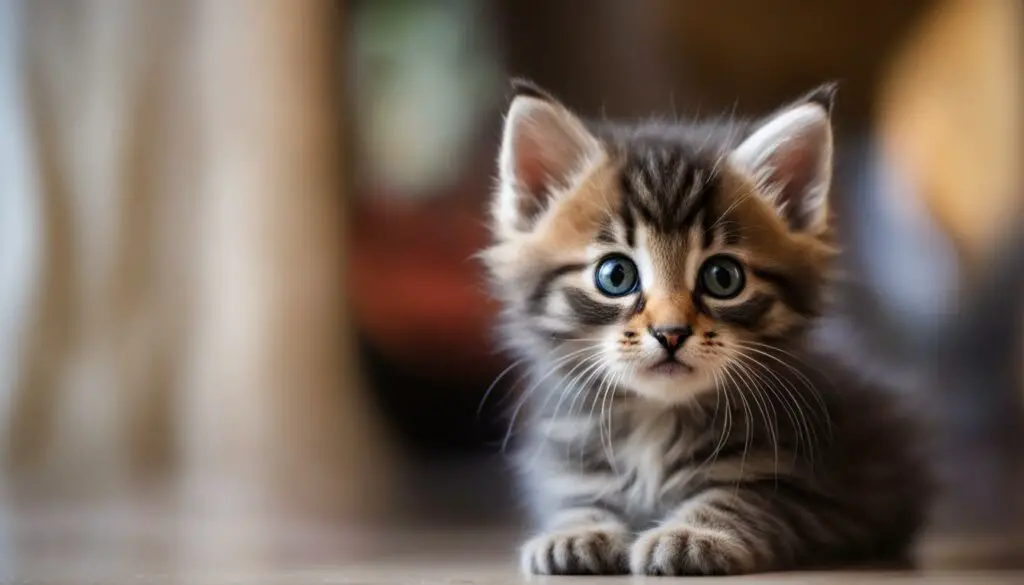Welcome to my blog! Today, we’re going to delve into the fascinating world of kitten begging behavior. If you’ve ever wondered why your adorable little furball engages in this irresistible behavior, you’re in the right place. From kneading to staring, we’ll explore the reasons behind these cute and puzzling actions. So, let’s dive in and uncover the secrets of our furry friends’ behavior!
Key Takeaways:
- Kitten begging behavior is an intriguing trait that many cat owners find adorable.
- Kneading behavior is a leftover instinct from kittenhood and can serve various purposes.
- Cats may knead to mark territory, express contentment, prepare for physical activities, or create a comfortable nesting spot.
- Understanding a cat’s body language is crucial in interpreting their affection or discomfort.
- Respecting a cat’s boundaries and preferences during petting is essential for a positive relationship.
The Instinctive Behavior of Kneading
When it comes to cat behavior, one of the most intriguing actions is kneading. Cats instinctively engage in this behavior, which can be traced back to their kittenhood. Kneading is the rhythmic motion of pressing their paws into a surface, often accompanied by purring and contentment. This natural behavior serves multiple purposes and is an essential part of a cat’s instincts.
As kittens, they knead their mother’s belly while nursing to stimulate milk flow. This instinctive behavior continues into adulthood, where cats may knead when they feel comfortable and secure. It’s a way for them to recreate the feeling of being with their mother, bringing them a sense of contentment and safety.
Kneading also plays a role in marking territory. Cats have scent glands in the soft pads of their paws, and when they knead, they activate these glands, releasing their unique pheromones. By doing so, they communicate ownership and establish their presence, marking their territory.
The Instinctive Behavior of Kneading
Nesting instinct is another reason why cats knead. In the wild, cats paw at piles of leaves or tall grass to create a comfortable and safe nest for themselves and their young. Kneading a blanket or a soft surface mimics this behavior, as it helps cats create a cozy sleeping spot and check for any potential dangers lurking within their environment.
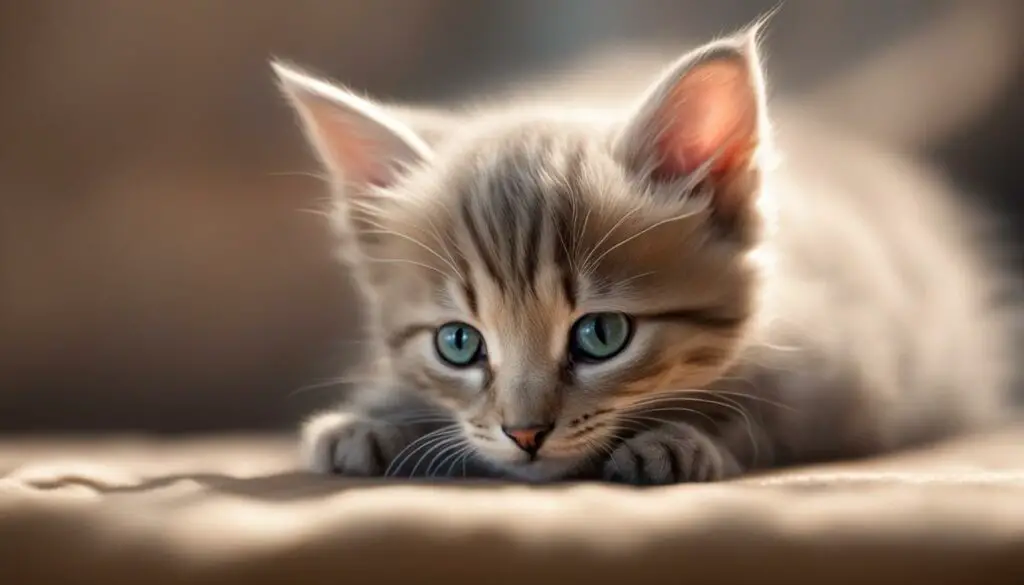
Understanding the instinctive behavior of kneading can provide valuable insights into your cat’s needs and preferences. By appreciating this natural behavior, you can enhance the bond between you and your feline friend, providing them with the comfort, security, and stimulation they instinctively crave.
The Nesting Instinct
When it comes to kneading behavior in cats, it’s not just about expressing contentment or marking territory. Another possible explanation lies in their wild instincts and the nesting behavior of their ancestors. Cats may knead blankets and soft surfaces as a way to recreate the feeling of creating a nest in the wild.
In the wild, cats paw at piles of leaves or tall grass to create a comfortable and safe sleeping area for themselves and their young. This nesting instinct is deeply ingrained in their DNA and can still be seen in domestic cats today. By kneading a blanket, cats may be trying to create a cozy sleeping spot, just like their ancestors did in the wild.
The Nesting Instinct in Action
A fascinating aspect of this behavior is that kneading may also serve a practical purpose. By pawing and kneading at a blanket, cats may be checking for any potential predators or hidden dangers that may be lurking. This instinctual behavior allows them to ensure that their sleeping area is safe and secure, providing them with peace of mind.
So next time you see your cat kneading a blanket, remember that it’s not just a random behavior. It’s a reflection of their natural instincts and a way for them to create a comfortable and secure space for themselves. Embrace their nesting behavior and provide them with cozy blankets or beds to satisfy their instinctual needs.
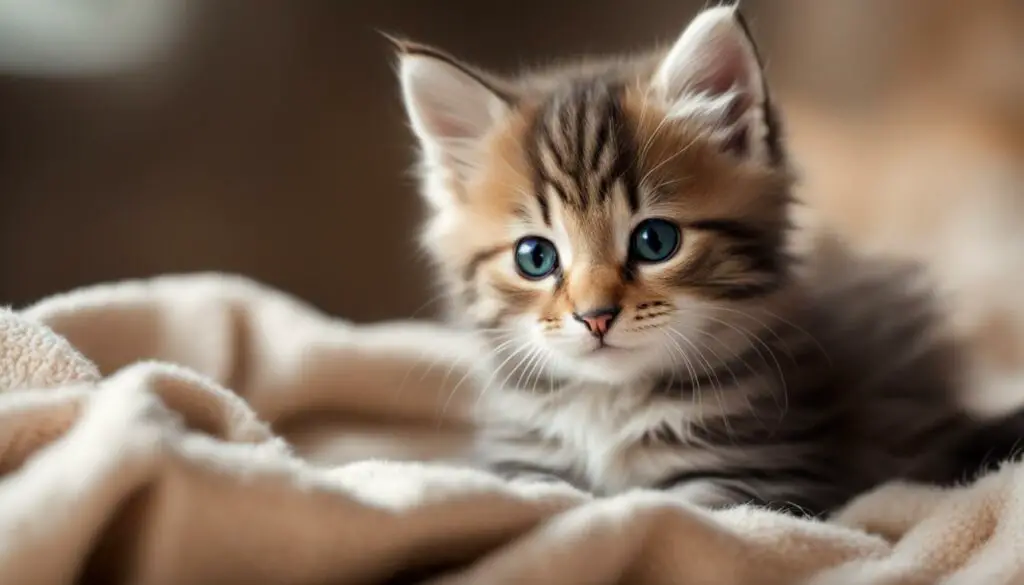
| Pros of Nesting Behavior | Cons of Nesting Behavior |
|---|---|
|
|
Marking Territory Through Kneading
One of the fascinating aspects of a cat’s kneading behavior is its connection to marking territory. Cats have scent glands in the soft pads of their paws, and when they knead, they activate these glands to release pheromones. This behavior serves as a way for cats to mark their territory and communicate with other cats.
When a cat kneads on you, it can be interpreted as a sign of affection and ownership. By kneading on your body, the cat is marking you as their own and warning other cats to stay away. It’s their way of claiming you as part of their territory.
To better understand this territorial marking behavior, it’s helpful to look at the science behind it. The scent released from the scent glands contains chemical information that other cats can detect. This chemical communication allows cats to establish boundaries, avoid conflicts, and navigate their social interactions. Kneading is just one of the many ways cats use scent marking to communicate.
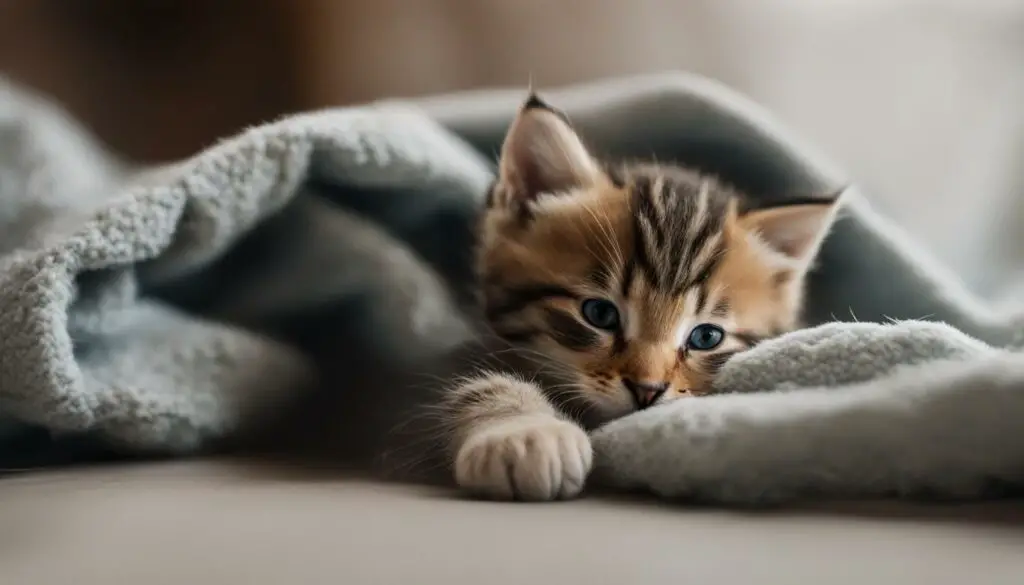
The Role of Kneading in Territory Marking
When a cat kneads, they push their paws into a surface and flex their toes, allowing the scent glands in their paws to release pheromones. These pheromones not only mark the cat’s territory but also provide information about the cat’s identity, health, and reproductive status.
This territorial marking behavior is more commonly seen in unneutered cats, particularly during the mating season when they are actively seeking a mate. However, both male and female cats can engage in kneading as a way to mark their territory.
It’s important to note that while kneading is a natural behavior for cats, excessive or aggressive kneading can be a sign of stress or anxiety. If you notice any concerning behaviors or changes in your cat’s behavior, it’s best to consult with a veterinarian or a professional animal behaviorist for guidance.
Kneading as a Sign of Going Into Heat
Female cats may engage in kneading behavior when they are in heat. This behavior is often accompanied by other signs of being in heat, such as increased vocalization, restlessness, and a desire to go outside. The kneading, along with stretching and purring while lying on their side, is a way for female cats to signal their receptiveness to male cats.
During this time, female cats may display more affectionate behavior, seeking more attention from their owners and rubbing against objects. It is important to note that not all female cats exhibit kneading behavior when in heat, and some may display different behaviors altogether. Neutering or spaying your cat is a recommended option to prevent unwanted pregnancies and certain diseases.
Understanding and recognizing the signs of a female cat in heat can help pet owners provide appropriate care and prevent any accidental mating or unwanted litters. It is important to keep female cats indoors during their heat cycle to reduce the risk of unplanned breeding and potential health issues associated with pregnancy.
Estimated Duration of Heat Cycle in Female Cats
| Stage | Duration |
|---|---|
| Proestrus | 1-2 days |
| Estrus | 4-10 days |
| Metestrus | 4-10 days |
In general, the entire heat cycle in female cats can last approximately 7-21 days. However, each cat may have individual variations in the duration of each stage of the cycle. It is crucial to monitor your cat’s behavior and consult with a veterinarian for guidance on managing your cat’s heat cycle and reproductive health.
Stretching and Loosening Muscles
Cats are known for their agility and athleticism, and kneading may serve as a way for them to stretch and loosen their muscles. By engaging in this behavior, cats keep their muscles loose and ready for running, pouncing, jumping, and fitting into small spaces. It is their way of preparing for physical activities and maintaining their flexibility.
When cats stretch, they extend their bodies to their full length, reaching out with their front and back legs. This elongates their muscles and helps increase blood flow, allowing for better oxygenation and nutrient delivery. Stretching also helps cats maintain their balance and flexibility.
During the stretching process, cats may arch their backs and raise their tails, creating a natural curvature. This movement helps to align their spine and maintain a healthy posture. Additionally, stretching provides cats with a sense of comfort and relaxation, helping to relieve any tension or stress that may have built up throughout the day.
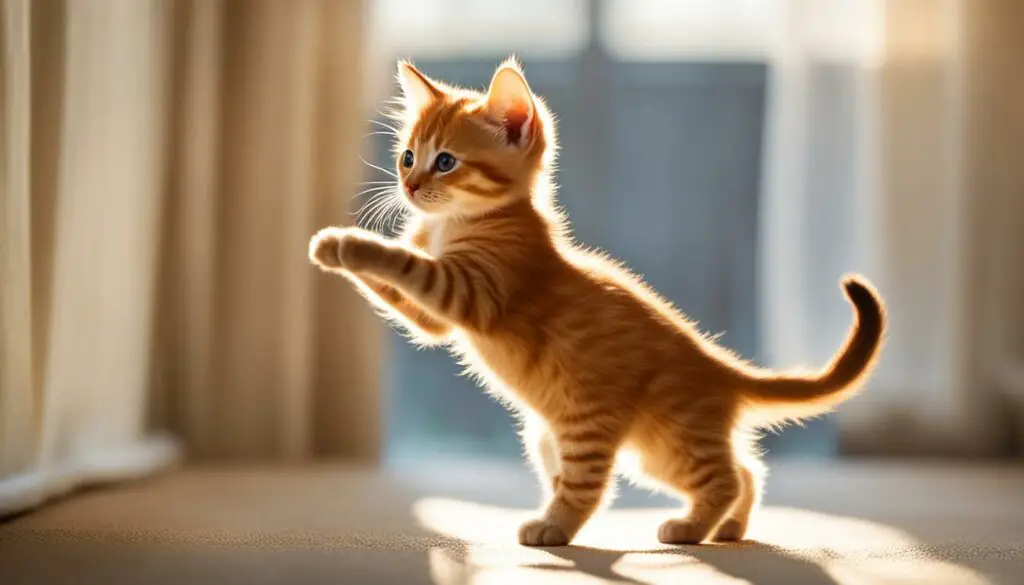
It is important for cat owners to encourage and provide opportunities for their feline companions to stretch. This can be done by creating a safe and stimulating environment with plenty of vertical spaces, such as cat trees or shelves, for cats to climb and stretch their bodies. Engaging in interactive play sessions with toys that encourage jumping and pouncing can also help cats maintain their physical fitness and flexibility.
The Benefits of Stretching for Cats:
- Improves muscle flexibility and range of motion
- Enhances blood circulation and oxygenation
- Helps maintain a healthy posture and spine alignment
- Relieves tension and promotes relaxation
- Aids in maintaining balance and agility
By understanding and supporting their natural stretching behaviors, cat owners can help their feline friends lead healthy and active lives.
How to Handle Kneading
While kneading behavior is commonly seen in cats and is often considered endearing, it can sometimes cause discomfort or result in accidental scratches. Punishing a cat for kneading is not recommended, as it is a natural behavior. However, there are ways to minimize the risk of getting scratched. You can place a soft barrier between you and the cat, such as a cushion or blanket, to prevent their claws from digging into your skin. You can also gently guide them to lie down and relax or distract them with a toy during playtime. Training and redirecting their behavior can help establish boundaries while maintaining a positive relationship with your cat.
One effective way to redirect kneading behavior is to provide your cat with a suitable alternative, such as a scratching post or a designated kneading pad. Offer positive reinforcement by rewarding your cat with praise, treats, or playtime when they use these designated areas. This will help them associate the appropriate objects with their kneading instincts.
Examples:
“I found that my cat loves to knead on a specific blanket, so I placed it on a comfortable chair for her to use. Now, when she feels the urge to knead, she goes to her special spot instead of my lap.”
If you find that your cat’s kneading behavior becomes excessive or problematic, you may want to consult with a veterinarian or a professional animal behaviorist. They can provide guidance and recommendations specific to your cat’s needs and help address any underlying issues that may be contributing to the behavior.
| How to Handle Kneading | Benefits |
|---|---|
| Place a soft barrier between you and the cat | Prevents accidental scratches and discomfort |
| Redirect kneading behavior to a suitable alternative | Provides a designated area for kneading |
| Offer positive reinforcement | Encourages appropriate behavior |
| Consult with a veterinarian or animal behaviorist | Get professional advice tailored to your cat’s needs |
Understanding Cat Petting Preferences
When it comes to petting your cat, it’s important to understand their preferences and provide them with gentle strokes that they enjoy. Cats generally prefer soft and gentle touch that follows the direction of their fur, mimicking the grooming behavior of their mother. By petting your cat in a way that feels natural to them, you can deepen the bond and create a positive experience for both of you.
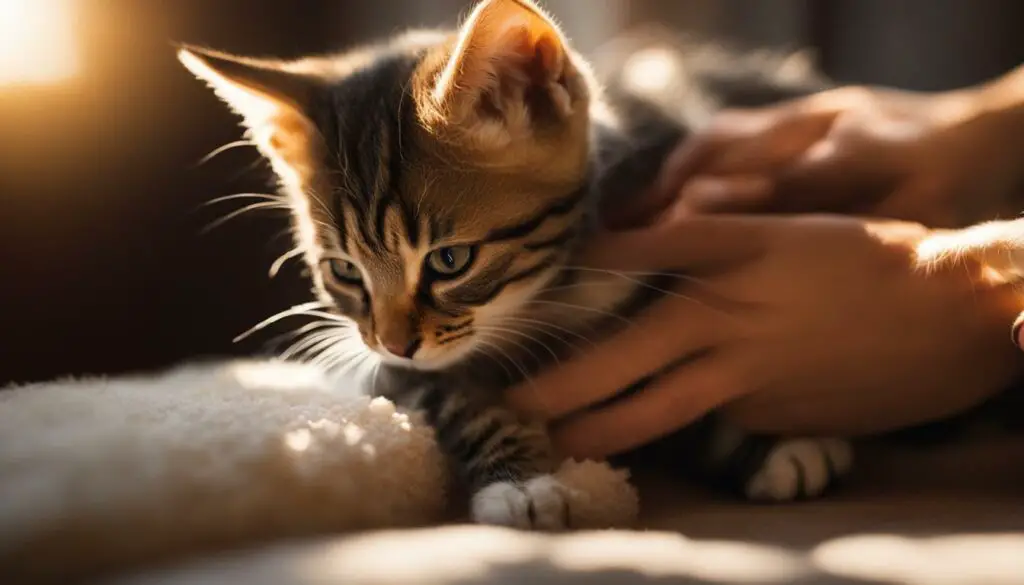
The best places to pet a cat are where their scent glands are located, such as between the ears, at the base of the ears, on the cheeks, and under the chin. These areas are sensitive and enjoyable for cats to be touched. Cats may also enjoy light pressure down their neck and back, stopping before the tail. Paying attention to these areas and petting them gently can help your cat feel loved and cherished.
Creating a Positive Petting Experience
- Use gentle, slow strokes: Avoid fast or rough movements that can startle or irritate your cat. Slow and gentle strokes are more soothing and enjoyable for them.
- Observe your cat’s body language: Pay attention to how your cat responds to your touch. If they tense up, move away, or show signs of discomfort, it’s important to respect their boundaries and stop petting.
- Provide options for interaction: Cats have individual preferences, and some may not enjoy being petted for extended periods. Offer alternatives like playtime or interactive toys to engage with your cat in a way they enjoy.
“Petting a cat is not just about physical contact, but also about building trust and understanding their unique preferences. By respecting their boundaries and providing them with affection in a way they appreciate, you can strengthen the bond and create a harmonious relationship.”
Remember, every cat is different, and it’s essential to adapt your petting technique to suit their personality and preferences. Building a positive and trusting relationship with your cat is a gradual process that requires patience, observation, and respect. By understanding their needs and responding accordingly, you can create a loving and fulfilling connection with your feline companion.
Signs of Tension or Discomfort
Understanding a cat’s body language is key to deciphering their emotions and needs. Cats have subtle ways of signaling when they are feeling tense or uncomfortable. By paying attention to their signals, you can create a more harmonious interaction with your feline friend.
Here are some common signs of tension or discomfort to look out for:
- Jerking their head
- Batting your hand away
- Hissing
- Shifting away
- Twitching the skin on their back
- Shaking their head
- Thumping their tail
- Rotating ears backwards
- Not responding with purring or rubbing
If your cat displays any of these signals, it is important to respect their boundaries and give them space. Continuing to pet or interact with a cat that is feeling uncomfortable can lead to stress and potential aggression. It’s best to observe their body language and adjust your behavior accordingly.
“Understanding a cat’s body language is key to deciphering their emotions and needs.”
| Body Language | Meaning |
|---|---|
| Jerking their head | Discomfort or irritability |
| Batting your hand away | Feeling overstimulated or defensive |
| Hissing | Sign of fear or aggression |
| Shifting away | Desire for personal space |
| Twitching the skin on their back | Sign of tension or annoyance |
| Shaking their head | Discomfort or irritation |
| Thumping their tail | Agitation or frustration |
| Rotating ears backwards | Sign of anxiety or fear |
| Not responding with purring or rubbing | Indication of unease or stress |
Each cat is unique, and their body language may vary. It’s important to spend time observing your cat and learning their individual cues. By respecting their boundaries and providing them with a safe and comfortable environment, you can foster a trusting and enjoyable relationship with your furry companion.
Importance of Understanding Cat Body Language
Understanding cat body language is crucial for maintaining a positive and stress-free interaction with your feline friend. Cats rely heavily on non-verbal communication to express their needs and emotions, and being able to interpret their signals can help you respond appropriately.
Cats have a complex range of body language cues that convey their emotions, from happiness and contentment to fear and aggression. By recognizing signs of tension or discomfort, such as jerking their head, hissing, or twitching the skin on their back, you can adjust your behavior and ensure a more comfortable experience for both you and your cat.
Being attentive to your cat’s body language also helps to strengthen your bond and build trust. By respecting their boundaries and providing them with a safe and comfortable environment, you create a positive association with your presence and interactions. This understanding of their body language allows for a deeper connection and a more harmonious relationship.
Positive Signs of Affection
When it comes to showing love, cats have their own unique ways of expressing themselves. Understanding their body language and responses to affection can help deepen your bond with your furry friend. Here are some positive signs of affection to look out for:
- The tail is held high and may even have a slight curve at the end. Cats often wave their tail from side to side as a friendly greeting.
- The ears are pointed forward and upright. This indicates that the cat is attentive and engaged with you.
- The cat has a relaxed posture and facial expression. Relaxed facial muscles, half-closed eyes, and a slightly open mouth are signs of contentment.
- Purring is a clear indication of pleasure and relaxation. It is a way for cats to communicate their happiness.
- Rhythmically pushing their paws in and out, also known as kneading, is a behavior that mimics the actions they took as kittens while nursing from their mother. It is a sign of comfort and trust.
- Gently bunting their head against you is a way for cats to deposit their scent and mark you as their territory. It is a sign of affection and trust.
These behaviors indicate that your cat enjoys your company and feels safe and loved in your presence. It’s important to recognize and reciprocate these signs of affection to strengthen your bond with your feline companion.
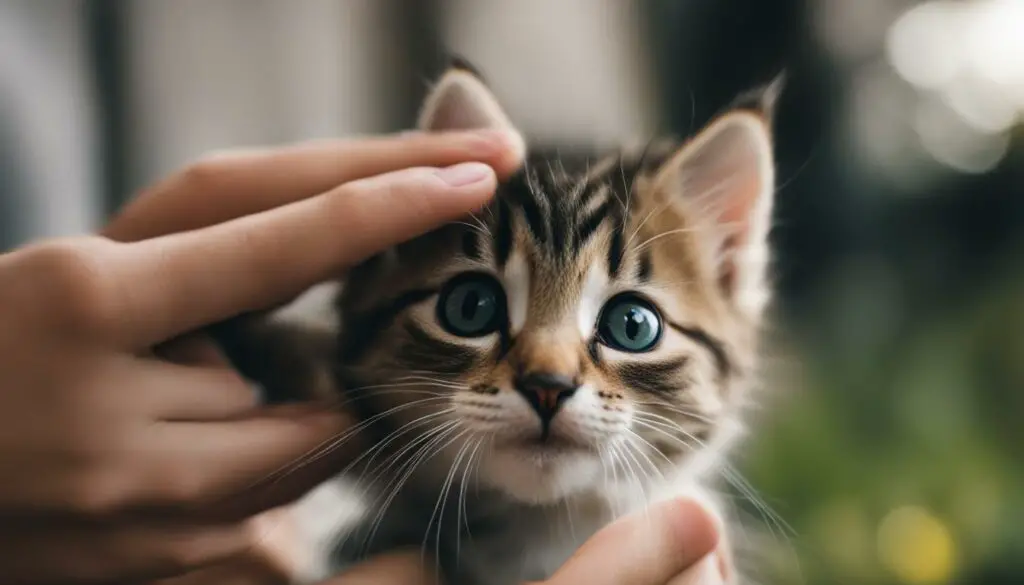
Staring as a Form of Communication
Cats have a unique way of communicating with their owners, and one of the most intriguing behaviors is staring. When a cat locks eyes with you, it can convey a range of messages, depending on the context and body language. Staring can be a form of communication, expressing a desire for attention, trust, or love.
When a cat stares at you with soft, relaxed eyes and blinks slowly, it is often a sign of affection. This slow blinking behavior is known as “cat-kissing” and signifies trust and love. It’s their way of saying, “I feel safe and comfortable with you.” To reciprocate this love, you can try blinking back slowly, showing your cat that you trust them as well.
However, staring can also have negative connotations. If a cat stares with dilated pupils, has an arched back, raised hair, and exhibits other signs of aggression or fear, it’s important to approach with caution. These are warning signs that the cat may feel threatened or anxious. It’s essential to give the cat space and observe their behavior to determine the cause of their distress.
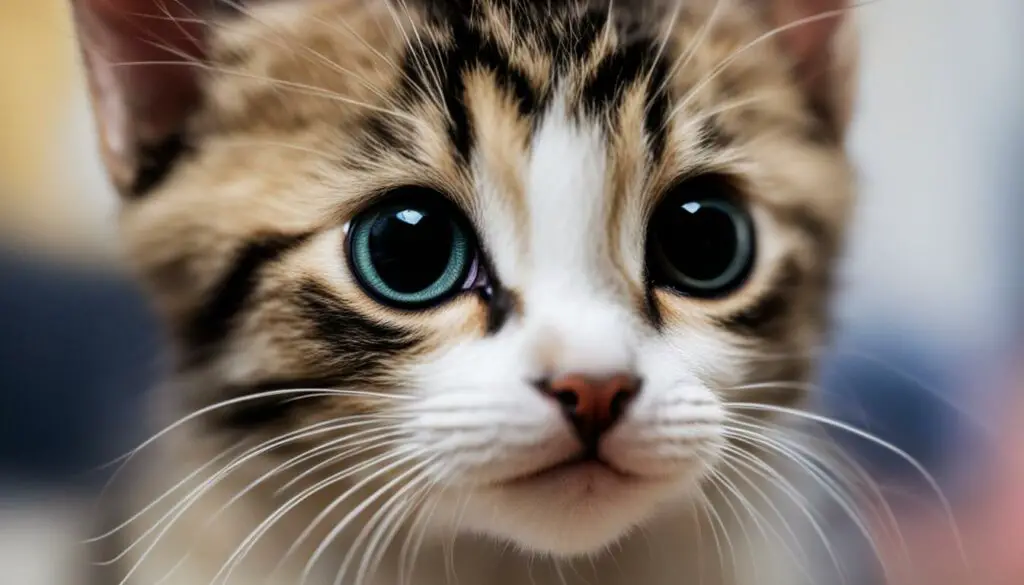
Every cat is different, and their body language may vary. It’s crucial to interpret the context and the cat’s behavior as a whole. By understanding the different meanings of staring, you can foster a stronger and more positive bond with your feline companion.
Staring as a Sign of Love and Trust
When a cat stares at their owner with affection, it is often accompanied by slow blinking. Slow blinking is known as “cat-kissing” and is a sign of trust and love. Cats may also deposit their scent onto their owner by pressing their head or cheek against their hand. Reciprocating the slow blinking and showing affection towards the cat can strengthen the bond. However, it is not recommended to stare back at a cat, as prolonged eye contact can be seen as a threat.
Staring is a form of communication for cats, and when they do it with affection, it’s a way for them to express their love and trust in their owners. Slow blinking is a behavior that cats use to show their affection. When a cat slowly blinks at you, it means that they feel comfortable and safe in your presence. It’s their way of saying “I trust you.” By returning the slow blink, you are reciprocating their love and building a stronger bond with your feline companion.
Another way that cats show their love is by pressing their head or cheek against your hand. This is a behavior known as head bunting, and it is a way for cats to deposit their scent onto you. By marking you with their scent, they are claiming you as part of their territory and showing that they trust and love you. It is a sign of affection and ownership.
| Feline Behavior | Meaning |
|---|---|
| Slow blinking | Sign of trust and love |
| Head bunting | Marking you as part of their territory |
I absolutely adore it when my cat stares at me with those big, loving eyes and then slowly blinks. It’s such a heartwarming moment that makes me feel so loved and cherished. I always make sure to return the slow blink and give her a gentle head rub. Our bond has become even stronger since we started communicating in this way.
<!–
Staring as a Sign of Trust and Affection
–>
Staring as a sign of love and trust is a beautiful aspect of the feline-human relationship. It is important to understand the meaning behind their behavior and respond accordingly to strengthen the bond. By acknowledging and reciprocating their affection, you are creating a safe and loving environment for your furry friend.
Staring as a Sign of Aggression or Fear
When a cat stares at you with aggressive body language, such as flattened ears, a twitching tail, dilated pupils, an arched back with raised hair, growling, or hissing, it is important to recognize these signs of distress. Aggressive staring can be a warning sign before an attack or a display of play aggression. It is crucial to assess the context and the cat’s behavior to determine the appropriate course of action.
In the presence of aggressive behavior, it is recommended to remove yourself from the situation to avoid any potential harm. Give the cat space and allow them to calm down. If the aggressive behavior persists, consulting with a veterinarian or a professional animal behaviorist can provide further guidance in managing the situation.
“Cats may stare with specific body language cues that indicate their mood. It is important to interpret the context and respond accordingly to ensure a positive interaction with the cat.”
Additionally, staring may also be a sign of fear in cats. Fearful staring is often accompanied by other body language cues, such as a crouched posture, flattened body, and a tense facial expression. If a cat is displaying signs of fear, it is essential to respect their boundaries and create a safe environment for them. Providing hiding spots, minimizing loud noises, and gradually introducing them to new experiences can help alleviate their anxiety.
Understanding the body language of cats and being aware of the signs of distress can facilitate better communication with our feline companions. By responding appropriately to their needs and emotions, we can build trust and create a harmonious relationship with our cats.
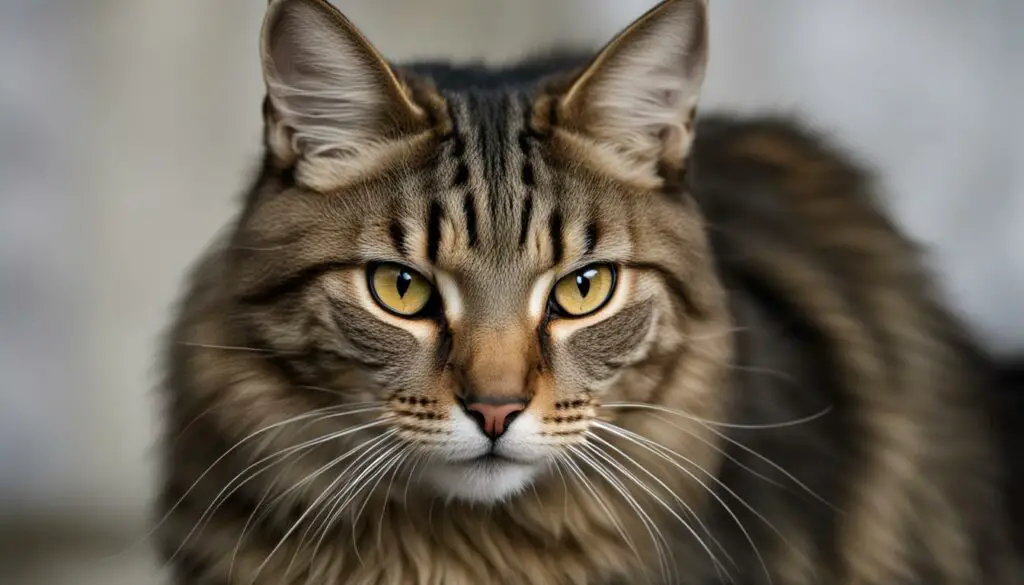
| Signs of Aggression | Signs of Fear |
|---|---|
| Flattened ears | Crouched posture |
| Twitching tail | Flattened body |
| Dilated pupils | Tense facial expression |
| Arched back with raised hair | |
| Growling | |
| Hissing |
Conclusion
Understanding and addressing kitten begging behavior is essential for any cat owner. By recognizing the underlying instincts and behaviors behind kneading and staring, we can better communicate and bond with our feline friends.
Respecting a cat’s boundaries and preferences when it comes to petting is crucial. Gentle strokes following the direction of their fur, focusing on areas with scent glands, are typically preferred. It’s also important to provide appropriate outlets for their instincts, such as playtime and enrichment activities.
Establishing a consistent feeding schedule and providing proper training can help prevent or redirect begging behavior. By meeting their nutritional needs and providing mental stimulation, we can curb their desire to beg for food.
Building a strong and enriching relationship with our kittens involves patience and understanding. With the right approach, we can ensure that our furry friends feel loved, secure, and content in our homes.
FAQ
Why do cats knead?
Cats knead as a leftover behavior from kittenhood, to mark territory, as a nesting instinct, or to keep their muscles loose and ready for physical activities.
Is kneading a sign of being taken from their mother too soon?
No, nearly all cats engage in kneading behavior, regardless of when they were separated from their mother.
Why do cats knead on blankets and soft surfaces?
Kneading on blankets and soft surfaces may be a nesting instinct inherited from their wild ancestors, creating a comfortable sleeping surface or checking for predators.
What does it mean when a cat kneads on a person?
Kneading on a person may be a sign of affection and ownership, as cats mark their territory and communicate with other cats through scent glands in their paws.
Why do female cats knead when they are in heat?
Female cats may engage in kneading behavior when they are in heat as a way to signal their receptiveness to male cats.
How does kneading help cats stretch and loosen their muscles?
Kneading helps keep cats’ muscles loose and ready for physical activities like running, pouncing, jumping, and fitting into small spaces.
What can I do to prevent accidental scratches while a cat is kneading?
Place a soft barrier between you and the cat, gently guide them to lie down and relax, or distract them with a toy during playtime to minimize the risk of getting scratched.
How should I pet a cat to make them feel comfortable?
Cats generally prefer soft and gentle strokes that follow the direction of their fur, particularly in areas where their scent glands are located, such as between the ears, at the base of the ears, on the cheeks, and under the chin.
How can I tell if a cat is not enjoying the petting?
Signs that a cat may not be enjoying the petting include jerking their head, batting your hand away, hissing, shifting away, twitching the skin on their back, shaking their head, thumping their tail, rotating ears backwards, or not responding with purring or rubbing.
What are the signs that a cat is showing affection?
Signs that a cat is showing affection include initiating contact, keeping their tail upright and waving it side to side, pointing their ears upwards and forwards, having a relaxed posture and facial expression, purring, rhythmically pushing their paws in and out (kneading), and gently bunting.
Why do cats stare at their owners?
Cats may stare at their owners to get their attention, understand what they are doing, express love and affection, or as a form of communication.
What does slow blinking indicate when a cat is staring?
Slow blinking is known as “cat-kissing” and is a sign of trust and love. Reciprocating the slow blinking can strengthen the bond between cat and owner.
What should I do if a cat is staring with aggressive or fearful body language cues?
If a cat is staring with aggressive body language cues, it is recommended to remove yourself from the situation. If the cat is displaying fearful staring, giving them space or addressing the source of their anxiety may be necessary.
How can I establish a strong and enriching relationship with my kitten?
Understanding and addressing the unique needs of kittens, such as providing appropriate outlets for their instincts, establishing a consistent feeding schedule, and appropriate training, can help build a strong and enriching relationship with your furry friend.
Source Links
- https://www.purina.com/articles/cat/behavior/why-do-cats-knead
- https://www.dailypaws.com/cats-kittens/cat-safety-tips/how-to-pet-a-cat
- https://www.yahoo.com/lifestyle/does-cat-stare-vets-reveal-130353701.html

